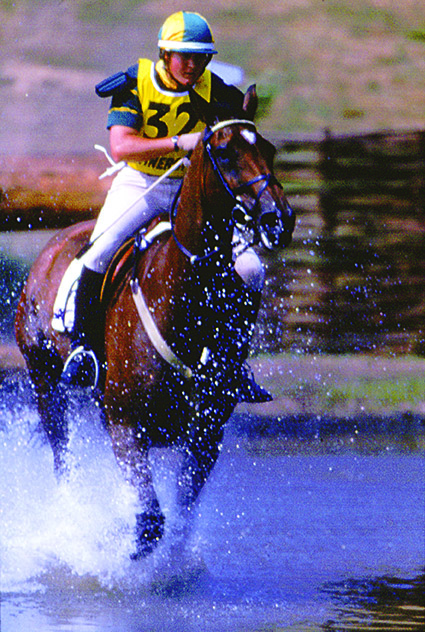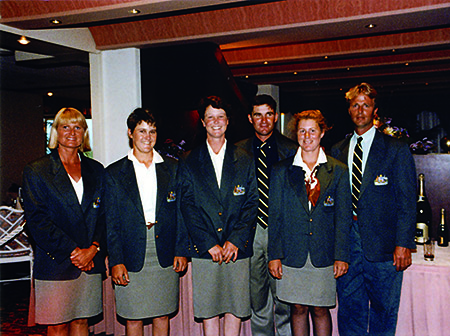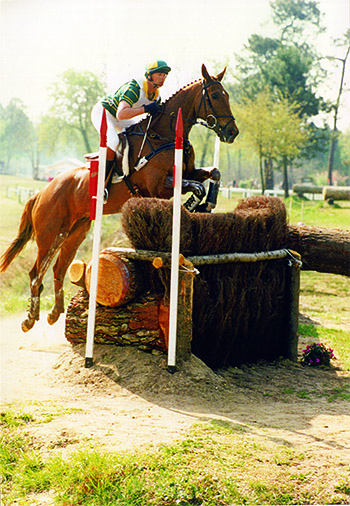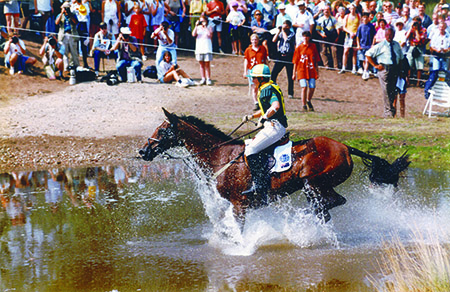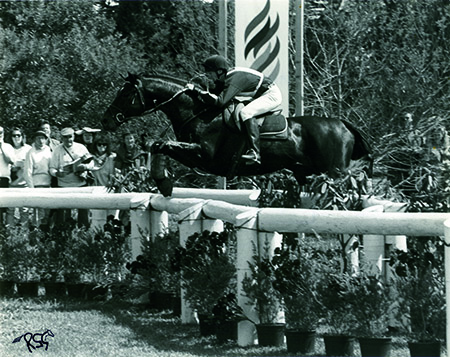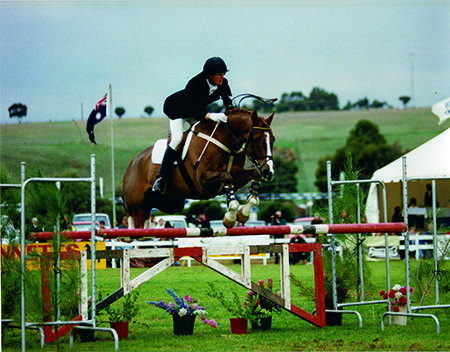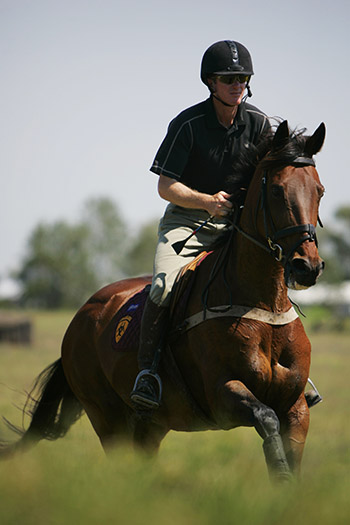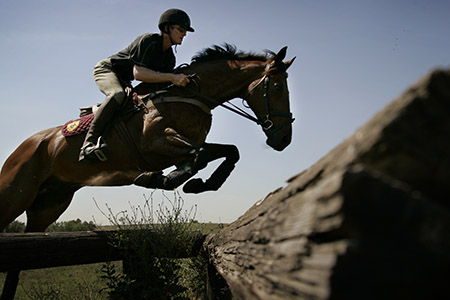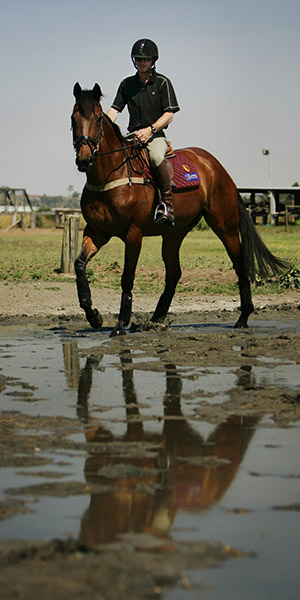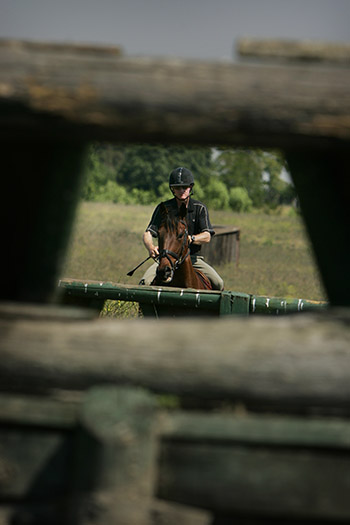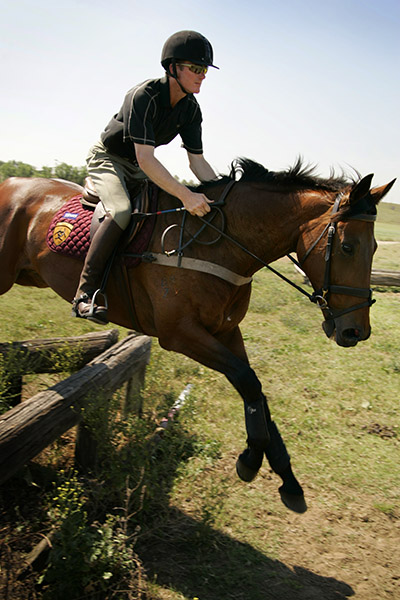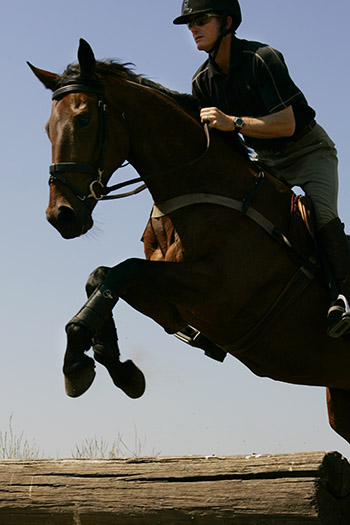Prue and Navarone at the WEG in 1994, photo – Edgar Schopel
Story – Chris Hector & Photos – Roz Neave, Edgar Schopel and archives
At Lochinvar in the early 1990’s it seemed liked every rider was headed for Olympic or World Championship Gold. In 1992, Matt Ryan blitzed the rest of the eventing world at Barcelona to take out individual and team gold. Two years later, Prue and her sister, Felicity Cribb, were in the Australian Team at the 1994 WEG in The Hague – with Prue leading the world after the cross country, only to drop to 10th after the showjumping.
The eventing team for the WEG at The Hague: Gill Rolton, Prue, Felicity, Phillip Dutton, Wendy Schaeffer and David Green
Prue, was hooked – for her the experience of working at The Centre, offered a lifetime career path:
“When I got to the Equestrian Centre I knew that’s what I wanted to do. Growing up, I think Felicity was the one in our family who everyone said ‘oh what a lovely rider’ – and she could ride anything. When Mum was dividing up the breakers – you do that one, you do that one – I was the youngest and I definitely got the quietest ones. Felicity got anything that was wild or bucked and she really was very good with the difficult horses. She was really tough.”
“The same with handling youngsters, I was just passing the wormers, I wasn’t wrestling them into the race. I am nearly four years younger than her I guess… But when I got to the Equestrian Centre I realised, yes, I could do this – I could ride at international levels.”
Felicity and Carmody Street on course at Saumur
It must have been something for you and Felicity to end up in the same Australian Team at the WEG in The Hague in 1994?
“Felicity had Carmody Street and Copper Charm, and the first time she came by the Equestrian Centre, she brought Copper Charm and put her on Heath’s truck to go to Melbourne 3DE. The following year, she had both of them, Copper Charm and Carmody Street, and I had Navarone by then. Even though they competed at the same time, she was competing Carmody Street in Queensland, and I was in NSW. Then Felicity went overseas. So it was really coincidence that both horses peaked at the same time, because we weren’t campaigning together, we weren’t even in the same country.”
“It was definitely a huge bonus for me to go to England on the way to The Hague, and have her already there, just to have that support. I was there for seven months – in those days you didn’t just go over three weeks before the event. That’s a pretty big upheaval – and it was good to have someone over there 100% on your side. Often when you go overseas, that’s the part people don’t realise, it’s all very wonderful to take your horse overseas, but gee, everyone is pretty quick to knock you down.”
“I didn’t have a great run when I took Navarone over there. I had a problem at a couple of One Day Events, and selectors knew about it just about before I’d finished the course! It’s not like that in Australia, there’s a lot more camaraderie, especially in NSW with the squad school system, people support each other a lot more – it’s not quite like that overseas.”
Through the water at The Hague and into the lead – Prue and Navarone…
The Hague was good news, bad news – Saturday night you were the leading rider in the world?
“That’s right, but even if you go back a week before that, I wasn’t supposed to be there. The selectors didn’t want me there at all. Matt Ryan was there with a broken pelvis and they just checked at the last minute, could he trot over a cross rail? We’ll come and see you Prue when we see if Matt can jump this cross rail… Get real, Matt couldn’t walk, much less ride. To be honest they took me under sufferance when it was obvious that Matt couldn’t ride.”
“In training camp, my horse was really sound, and then when we got to The Hague they were predicting 35 degrees, I remember David Green had Chatsby and Duncan, and Chatsby was definitely his second string horse at that stage and hadn’t been very reliable. Duncan had a lot of colder blood in him and they were thinking 35 degrees we’re going to need Thoroughbreds. Suddenly I’ve gone from pretty much convincing myself that I was going to be an individual, then I’m on the team. Wow!”
“When I got to The Hague I was trying to be a little bit invisible, I’ll just be an individual and do my own thing, and that’s okay. Heath was there as coach, so it was just like being at home – he’s yelling at me and I’m thinking I’m quite comfortable now. Suddenly I was in the team. In that two week period I went from them not wanting to know about me, to cross country night at the WEG and we were leading and wow, everyone was really interested. The horse was on the drip, it was all happening, and how were we going to do the warmup for the showjumping? Suddenly all the showjumpers were there and I had about ten people in the practice arena.”
“I can honestly remember thinking, pity you didn’t take me a bit more seriously six months ago. It has been admitted since, that they got caught, they didn’t expect me to be in that position. The interesting thing about it all with Heath, much as he does philosophise and go on a bit, leading up to that training camp, and I was getting all sorts of different messages as to where I should go and what I should do, and Heath gave me the best advice of them all, he said, ‘look you are on your own and you have to look after yourself – don’t expect other people to make a decision for you. Don’t accept their decisions’ – it was up to me. I think he was saying shake yourself, grow up and get on with it.”
“That really stood me in good stead with what happened at The Hague and what happened in the showjumping. It was horrendously disappointing. The most disappointing thing was, okay Navarone wasn’t known as the most wonderful showjumper, that was no secret, but to be fair to the horse he wasn’t always given the best ride either! He had jumped clear for the six months leading up to the WEG. He had the three rails at the WEG – I can still remember them to this day.”
“The first was the plank in the middle of the combination and he was actually doing manure, and even the showjumpers said, that was just unlucky. Then the next one, I just missed him, it was really bad riding – I wasn’t confident, it was a Liverpool and he was ditchy, terribly ditchy, and the last fence, I must say it did have our name on it. If there was going to be a fence we were going to have down, that was the one. So two probably could have been avoided so I always feel a bit responsible to the horse…”
Craig and Abduell – Craig’s first Advanced start at Werribee – they are jumping the fence where the first rider out, Lucinda Green fell and had to be carried off in an ambulance…
Meanwhile, Craig had been making a name for himself – placing sixth at his first Advanced 3DE start:
“The first horse I rode Advanced was the Warmblood stallion, Abduell. Heath was riding him at the time, and we were going to the big 3DE at Melbourne in 1989, when they were trying to get the Olympic Games for Melbourne. Heath had three entered for the Advanced and they would only let him ride two – so I got to ride Abduell. It is another one of those generous acts that no-one ever really gives Heath credit for.”
“I rode Abduell at an open intermediate ODE at Hawkesbury, and Advanced ODE at Warren, and then I went round the Melbourne Three Day Advanced.”
“There was carnage there that year – the first rider on the course was Lucinda Green who had been flown in with her horse for the event, and she got no further than the seventh fence! It was the charge of the Light Brigade from the Heath Ryan school of cross country riding.”
“I think Abduell went round clear. He was just a fantastic horse – really I was just going as fast as I could, and I knew nothing. I was just brave enough to kick it and do as I was told. He was a good school master at that level – he was actually better than that. I think we ended up running sixth at Melbourne, and the selectors wanted to have a look at him. That was my first introduction to selectors and teams, and all that. The team vet, Denis Goulding went in the stable and looked at dear old Abduell’s legs and he nearly had a fit. That was my first Advanced run, it only lasted until Melbourne, I think the owners didn’t think it was such a good idea to put such a young rider on their horse, and Johnny Cooper took over the ride, and won Kooralbyn 3DE with the horse.”
“After that I bought an old advanced horse, Marksbury Way. He was a bit of a bolter. I rode him Advanced. It was a good gap horse, he basically taught me how to ride the Advanced courses slowly, because you couldn’t let go of the reins. He just wanted to go too fast.”
Elbacee Masterpiece at Gawler in 1993
“After that I rode a couple but Elbacee Masterpiece was the next big one. He came up and won the Melbourne two star in 92, when the course was absolutely flooded. I think he won the three star in 94 – and he was long listed after that. He came from a client of ours who was having trouble holding him, he was a difficult horse in the dressage and a difficult horse to hold on the cross country. He just took a while to school. He was never brilliant in the dressage, we got a good test at Melbourne and would have been mid-field, but again it was just one of those years where everyone had trouble. Then he jumped clear in the showjumping… it was the year poor old Nikki Bishop fell off in the showjumping and Blyth Tait had a rail down, and we ended up winning. The horse was a brilliant jumper.”
Was that painful then to sell him to Eddy Stibbe?
“Yeah it is always a bit painful. You can make all the excuses under the sun, but my feeling was that the dressage was never going to be good enough. That’s why we let him go. I guess Wendy Schaeffer had one that was never good in the dressage either, and she just hung on to it and went on to win a gold medal with him. But to be perfectly honest, at that stage of my career, I was there to make a living. I don’t like scratching for every penny.”
Next Episode: Prue sets herself for Sydney and the Olympic Games – and Craig starts breeding the eventers of the future…
Craig Barrett answers the question: CAN YOU TEACH CROSS COUNTRY?
“Absolutely. Cross country these days is a bit more sophisticated than it used to be. You used to just have to be a bit gung ho, a brave rider, and the cross country was pretty straight forward. But these days it’s tending to go closer to the showjumping, it’s becoming much more technical, all the distances are related and all the tougher fences are related. You don’t often find a single fence these days that pulls anyone up – it’s usually a related fence that causes the problems. These days the trend is to narrow fences: apexes, arrowheads – and they cause runoffs rather than falls.”
“In teaching cross country, I tend to concentrate on five things.”
* LINE
“First of all your line to the jump is the most important thing. It’s pretty much the only thing that the horse cannot change at the last moment. If you are on a bad line to an arrowhead, or a bad line to an apex or a related fence, the horse can’t fix it. They can’t get there and all of a sudden, drift in the right direction. That’s the most important thing – and that is pretty much the same in both showjumping and cross country.”
* PACE
“The rider has to become very good at judging the pace they have to ride a particular fence at. They have to be able to bring the horse back, or ride the horse forward, to get the required pace for a particular obstacle.”
“Drop fences into water are ridden at a particular pace, apexes at another, arrow heads are different, ditch and brush are going to be faster. So each and every fence has its own pace and if you can’t grasp that, then you are going to have trouble. Your horse is soon going develop confidence issues if you are riding at the wrong pace for that particular fence.”
“If you are going too fast to an upright, the horse might hit it, or too fast to a drop into water, then the water might slow them down and they fall, They might catch a stifle if they are going too fast into water. Conversely if you go into a ditch and brush too slowly, then the horse is going to struggle to get over it.”
* POSITION
“Teaching cross country riding first of all the rider has to develop a very good position. Position so that they don’t fall off, position so that they allow the horse the freedom to jump. Going cross country they have to be comfortable that they can stay with the motion, maybe getting a little behind the motion if they have to, slipping the reins if they have to, keeping their legs forward, if they have to. I like to say if you freeze the photo and take the horse out from under the rider, then the rider should land on their feet – if not they should fall on their bottom, their feet should be gently in front of them. They should never be falling on their face. That’s a general rule.”
“Cross country riders we tend to be a bit more like steeplechase jockeys, we fold a bit too much at the waist, and we close the angle of our hips a little too much compared to showjumping.”
“The cross country position does revolve around folding at the waist and being able to keep the legs a little more forward than the showjumping position.”
* RHYTHM
“If the horse is in a nice rhythm and is watching the fence, and travelling in a balanced fashion, then they are going to jump better. If the rhythm changes at the last minute and the rider is adjusting the rhythm by charging or hooking at the fence in the last few strides, then that makes it difficult for the horse.”
* TAKE OFF DISTANCE
Some coaches say you don’t need to see a distance, but I don’t agree. I think it is very important that the rider learns to see a distance. It’s more important to be decisive than it is to be correct. A lot of people get worked up about being correct, and how badly they rode a fence when they didn’t get the right distance. It’s actually much more important to be confident and decisive about choosing a distance.”
“Sometimes I’ll choose the wrong distance but I will have chosen my distance and my horse will say ‘yes, he’s chosen that distance’ and we leave the ground. The horse develops confidence that you are going to tell him to take off at a particular time. Now I think even the best riders in the world will tell you that they don’t make the right decision every time, but they have to be able to make a decision as to where they take off.”
“I think I got those five things from Jack le Goff, who trained the Americans years ago, and they mightn’t be exactly the same as he laid it out, but his five things were very similar. If you stick to those five: if you have the line right, the pace right, a good position, a good rhythm, and you start to see good distances, then you are going to be successful – whether you are jumping cross country or show jumps.”
Do you learn that on a cross country course or can you learn them in a showjumping arena with poles?
“I think you can break them down and learn them in the jumping arena. You can practice those five things whenever you jump – even if you jump a cross rail, you can still concentrate on those five things. It can be broken down and practised over the showjumps but I believe for the horse to go cross country, you have to cross country school.”
“I don’t like teaching cross country to people I don’t know because it is difficult to know where they are at, and obviously the jumps are solid. All my horses cross country school regularly on the Lochinvar course – I’m there once a week, schooling horses and training riders. I do believe you have to get out there on cross country jumps to learn about it, and see how the horse reacts. The horses have to become confident with those fences, and that means schooling time and time again. Some horses don’t need a lot of training once they get to intermediate / advanced, but I think generally the advanced horses still need to practice related fences with solid obstacles.”
You say you can teach cross country, but at the end of the day are there some riders who just have ‘it’?
“Some people are going to make a decision, do I really want to do this or not? That may revolve around personal experience – whether they’ve had a fright, whether they’ve had a fall – too many falls, too many stops, they don’t quite understand why they do it. But I think it is definitely a personal decision – do you want to be an eventer or don’t you? That’s just a decision they make. I don’t think it’s necessarily that you’ve got it or you don’t. If you want to do it, then you’ll be able to be trained, and that’s the bottom line.”
“Some people want to ride showjumping, some want to ride dressage, some want to event. If you get a fright then the important thing is that you are able to break it down and understand why you had that problem. That’s the most important factor in staying confident – being able to understand why a particular problem happened. If you are not able to understand why it happened, why it keeps happening, and you don’t get to the bottom of the problem, then that will probably pull you up.”
I’ve spent a fair bit of time sitting in ten minute boxes with some really good cross country riders, and they don’t look as if they are about to enjoy the next 13 minutes or so…
“They will all tell you that they get real nervous before they go out. Mark Ryan would be sick in the ten minute box – if he wasn’t vomiting he wasn’t trying hard enough. Everyone gets nervous. What you have to recognise is that nerves aren’t a problem. It’s just an issue you have to deal with. Everyone is going to be nervous but if you get into the head of those good riders, the moment they get out of the start box, they are on the job. You have to recognise, yes I am nervous but this is okay and now I have to focus on the job.”
“What happens is riders get ahead of themselves. They get nervous, then they start worrying about the outcome, and once you start worrying about the outcome, then you forget about what you are supposed to be doing, and then you make mistakes. But you say, oh it was because I was so nervous. It’s not actually the nerves, it’s the fact that you stop doing the job that you need to do. There’s lots of people that get nervous. The V8 super car drivers, they’ll get nervous on the starting grid, no two ways about it… but once the green light goes, they follow a pattern that gets them into the job they have to do. A lot of people do that naturally but this is where sport psychologists make a living.”
Have you ever met one who did anything useful?
“Yeah. John Crampton who does the Sports Institute videos is really good, very perceptive and he helped a lot of the guys. I think too many of them try to help you in a way that they think they can give you something to do after you finish riding – that’s just crap, we don’t want to know about after we finish riding. I’m a golf enthusiast and golf is said to be 90% in the brain. I’ve read quite a few books on the psyche of golf – it relates to any sports person. The problem comes when you get ahead of yourself – when you start thinking about the outcome.”
“My problem is that I make mistakes in the dressage test and it is because I get ahead of myself thinking the horse isn’t going well enough for the next movement. As soon as you do that you’ve stopped thinking about where you are supposed to go, so you make an error of course.”
“It all comes down to staying in the present, and most natural athletes will do all those things naturally – but the psychologist can help the people who don’t think about what they are supposed to think about in those pressure situations. Showjumping last, under pressure, 0.2 up your sleeve, you must go clear, you must go under time, the nerves start to take a hold. What happens is the rider goes into the ring and starts worrying about knocking a rail down. That’s natural. But if you get into the guys who jump clear rounds to win, I guarantee that it never entered their heads, from the moment they left the practice arena, they will have never ever, not for a second, thought about knocking a rail down. They will have only thought about the job that they have to do. I want this pace, I want this rhythm, I want this turn, I want this release: I want to look here, I want to get out here, I want to be here. If they stick to that, they give themselves the best possible chance to jump a clear round.”
“As soon as you worry about knocking a rail down, you are not thinking about your best chance to win the competition. You think about knocking a rail down and that’s what’s going to happen.”
“You stop thinking about where to give you the best opportunity to win the competition. Canter in: where am I going to salute the judge? where am I going to do my canter circle before the first fence? How far do I want to get out for this turn to make the time? Do I want to cut down here? Winning riders concentrate for the whole round on what gives them the best opportunity to leave the rails up. The moment you canter through the start and think ‘gee I hope I’m not going to have a rail down…’ you have switched to the outcome, and you are dead.”
There are people say, you can school all your cross country using showjump rails, is there a danger of producing overly technical riders with this approach? Riders who get a bit obsessed with the perfect stride, and losing the natural flow that very good cross country riders have?
“I think it is a combination of both now. I think you do have to be very technical, and the more technical the cross country becomes, the less you can just float your way through. You can’t just gallop in and blast your way through anything. I remember 1989 at Melbourne, that was my first start – with Heath, it was the Charge of the Light Brigade – and that worked then. There were still some technical fences but Heath made the decision that we would blast our way through. That’s happening less and less now, you can’t choose to blast your way through a lot of the time. You actually do have to be very technical. I think the really good guys will still look like they’ve done it beautifully.”
The really good guys can do it un-beautifully and still keep coming. There’s one classic photo of Stuart Tinney at the first water at Sydney 3DE, and he is eighteen inches out of the saddle on Carrera, and you can’t believe he keeps going and finishes the jump – but he does?
“I think if you go back to those five points. If he had the line right, the pace right, his position was good enough, he’s allowed a margin and his margin is much greater because his position is so good. He would have had everything else right – and because everything else is covered, he has a greater margin for error than the rider who comes in wrong line, bad pace, position not quite as strong. Their rhythm was ordinary so the horse wasn’t able to look at the fence so well – and then they don’t have a great distance. Well their margin for error is so slim, that’s why you get falls.”
There are some riders – like your wife Prue – that when you see them ride cross country they are in such a channelled direction forward, and you see other riders who fold in on themselves, and they are the ones who fall – while it’s the riders like Prue who are fixed on the horizon and going there no matter what, who get over the jumps, even if sometimes it is not pretty…
“If you talk about Prue, and she probably doesn’t like me doing that too much, she is probably one of the most focussed competitors that Australia has produced. Her ability to stay in the present was absolutely fantastic – so there was never a question in those big competitions as to what was happening. She’d never for a second have even a glimpse that anything was going to happen except this, this and this. If it did for some reason, she was so well trained that the margin for error was very high. The focus and the concentration on staying in exactly what she had to do for that particular fence and not worrying about anything else – that’s what allowed her to just go bomp, bomp, bomp over the fences. Never looked like making a mistake.”
Is it dangerous going out cross country schooling?
“Absolutely.”
What can we do to minimise the risk?
“You have to go with someone who knows what they are doing. That sounds obvious I know. We’re lucky we have the Lochinvar cross country course just down the road. Heath is very experienced, so all the fences he has down there, I can take a horse and rider from Prelim to Advanced, and work on five main fences. Those fences are set up in such a way that you can school them from Introductory to Advanced. We have a system and we have a pattern – and my pet hate is if I work out a pattern of fence schooling, then I say to the next rider, ok, ride that pattern – and they go and make up their own pattern. That’s my pet hate because they weren’t concentrating, they don’t understand that that pattern has evolved over 15 years, and that pattern will actually get you to Advanced.”
“By pattern I mean, I jump a small vertical, then I jump a small apex, then I jump a small bounce, then I jump a small log oxer, then I jump a small ditch, then I jump a bigger ditch, then I’ll jump a trakehner, then I’ll jump a little bank, then a big bank, then we’ll go to the water and we’ll trot into the water without having to jump in, we let them have a splash around, I drop down a small bank, I trot through the water, come around again, drop in, canter across, jump out over a small fence, come around, drop in again, canter through, do it twice, then we work round until we are jumping a single fence into water, then a one stride double, then we jump a bounce into water. What I have described – that will take you two years to get to that stage.”
“Then we’ll jump a vertical, five short strides, vertical into water, five short strides, a bounce, up a bank and over an arrowhead – and that is your three star training. That will take you three years.”
“Follow that pattern week in week out and you will get there. I know that pattern will get me where I want to go.”
Are there some horses that the first time you school them over a cross country fence, you say to yourself, okay, this is a superstar?
“You get a bit of an idea. Especially if you trot up to a ditch and it looks at it and jumps it, and doesn’t mind. If you trot it to the water and it jumps into the water and doesn’t care… you go, oh, that’s good. If you trot to the ditch and three strides out, it has turned the other way and headed home, then it, ooh, this is going to take some work. Some horses just don’t mind ditches, and the really good eventers are the ones that don’t mind ditches, they don’t mind trotting into water, they don’t mind jumping down a bank AND they are still really careful – they are the eventers.”
George Sanna has the theory that Warmbloods are much more visually spooky than Thoroughbreds, with more Warmblood coming into the eventers, are there going to be different schooling issues that will arise?
“I sure there will be. The more spook you have, the more training over solid fences you have to do. Some horses you can train the spook out of them – some you can’t. Repetition is the only remedy. It depends on their own confidence and their own jumping ability. If they are a very good and they spook, go to the jump and jump go higher, you’ll be fine. But the ones that get there – spook – and want to just skim over. They are the ones that worry you. They may spook but they still have to go high.”
“Those spooky horses do require more training. A horse that comes to a combination of a ditch and brush, three strides to triple brush arrowhead, really big and really difficult – like they have at Adelaide – if your horse is spooking at the ditch and brush, then you are not going to be in great shape to get to the triple brush.”
“Having said that, look at the way David Middleton has worked with his horse, Mr Shirvington, he has taken it all over the country, done a couple of 1 Star three day events, he has done lots of miles at those lower levels – that’s how you fix them. You don’t go up too quickly with the ones that want to spook. You give them lots of time at the lower levels and that slowly but surely winds that spook down and you end up with a really good, honest cross country horse.”
Is this where riders need an advisor to tell them which events they should enter – and which to stay clear of?
“That is one of the biggest issues, getting riders through the maze. One of Heath’s great philosophies is that we are all born 3 star riders, most people who sit on a horse early enough, but so many get lost in the maze without good accurate information. Yes, you do need good advice.”
“I would not advise anyone to go cross country schooling on their own, I think that is dangerous. Even if you have a simple stop, you need someone there to help – to say, this happened, this is what went wrong, now canter in a do it again. But if you run into problems on your own, a simple problem can become a major issue – and you’ve got to avoid that.”
“Most of the events are okay but what is important is how you make the transition from one grade to another – one grade to another is where your biggest trouble will come. It doesn’t matter what grade it is, the jump from one grade to the next, is quite difficult. You need to have an experienced rider you can ask – ‘is this a good place for me to do my first Novice?’ People will often ask me where they should do their first Advanced, and I often advise them that the bigger more straight forward courses are better than the smaller, tricky courses.”
“I don’t mind taking a horse somewhere like Goulburn. It will be the biggest one day event you’ll see all year as far as size goes, but the fences are very well built and there is never anything that is trappy. It is very straight-forward, and there is always an option if you are on a greener one. All the fences around the course will be relative in their height. They might all be big, but they are all the same. You don’t all of a sudden start out with ten small fences and then five huge three and a half stars, then you are back to novice fences again – which can happen. That’s tough to get it right.”



